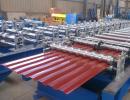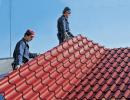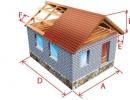Minimum roof bias: how to calculate
If in your region the strong wind is frequent guest, when building the roofs it is recommended to set the minimum bias of the roof. This is due to the fact that with increasing the angle of slope, "sailboat" increases. Therefore, loads on the carrier roof structures increase. Further about it in more detail.
A little roof is a roof, the installation of which was carried out at the calculation of the smallest, recommended angle of tilt of the slopes. For each roofing material, the minimum slope of its own.
What is the roof slope? This is the angle of inclination of the roof to the horizon. What is it needed for? Anyone can say than the more tilt, the faster the water will flush from this surface.
Consequently, snow, dirt, water and leaves will be delayed on the roof with a large block angle of slope. In addition, the design of such roofs is more simple, almost any roofing materials can be used for the coating, and the roof itself looks much more interesting. And what affects the angle of inclination?
What does the roof bias depend on?
No one will argue that the main functions of the roof is the protection of the structure from external factors.
That is, the roof must be waterproof, reliable and durable. Therefore, it is necessary to approach the selection of structures and roofing materials.
And here the angle of inclination of the roof will be played, and it depends on the following factors:
- Wind. The higher the roofs, the higher the "sailboat", the resistance of the wind. Low-old roofs are used in building buildings in areas where strong winds.
- Precipitation. The speed of water flowing on low-diabetes roofs is significantly lower than on high roofs. Therefore, mud and foliage can be delayed on them, especially if materials with a rough surface were used for the coating.
- Roofing materials. For each roofing coating, there is a minimum angle of inclination at which this material can be used.
- Traditions. In each region, one or another roof design is preferred. And this factor should also be considered.
For your information! Progress does not stand still. New roofing materials appear that allow solving many problems. Architects can create projects that can not only implement the desire of customers, but will comply with all standards and traditions for the region.
What is measured angle

The roof is measured in degrees or percentages. Their ratio is listed in the table in Figure 2. The angle of the slope is measured using a biasmaker or mathematical method.
The incluster is a rail with a frame, between the planets of which there is an axis to which the pendulum is attached + division scale. If the rake is in a horizontal position, it will be zero on the scale.
To determine the angle of inclination of the roof, the rail is kept perpendicular to the skate. On the scale the pendulum will show what the slope of this roof in degrees.
Mathematical means this value is as follows. What is the angle of inclination of the skate - the ratio between the height of the skate and half the downstream of the roof (the width of the building is divided into two).
To get a value in percent, the number obtained is multiplied by 100. Next, if you need to know the value of the slope in degrees, we translate along the table. To be clearer, consider on the example.
The width of the building is 7 m, the height of the skate is 0.6 m. We obtain: 0.6: (7/2) \u003d 0.17, now multiply 0.17x100 \u003d 17%. We look at the table: 17% \u003d 10 degrees. That is, the angle of inclination of the roof will be 10 degrees.
The designation of the roof shaping in the drawings can be both in degrees and in percent. The slope is indicated by the English letter "I".
Some may be denoted in pm, but they say it is not very convenient.
In SNIP II-26-76, this value is indicated as a percentage. That is, someone as convenient, at the moment there is no strict rules about this.

Now consider the minimum roof inclination angle for the most common roofing materials.
The minimum roof inclination angle for roofing materials:
- Membrane coatings. You can use for roofs of any design. Minimal bias 2 degrees.
- Rolled materials. When laying 3 and more layers, the minimum angle will be 2-5 degrees. If you plan to settle two layers or less, the angle will be 15 degrees.
- Ondulin - 6 degrees.
- Soft tile. You can use at an angle of inclination of 11 degrees, but the material is placed on a solid crate.
- Professional flooring. The minimum angle of inclination will be 12 degrees, but it is recommended to further squint the joints to sealants.
- Metal tile - 14 degrees.
- Slate, tile. So that the moisture is not delayed on the roof and did not succeed inside the roof in the joints of the joint, the minimum angle of inclination should be 22 degrees.
Materials figured out. Now list some points that should be taken into account when building the roofs with a small slope.
Namely:
- Proper to equip the drainage system. It can be internal (water receivers are located on the roof itself and the slope is made in their direction) and the outer (water flow outside the roof, in the gutters).
- With less recommended by 10 0, it is necessary to mount the waterproof bottom roof.
- The smaller, the greater the underlined ventilation gap.
- If the roof slope is less than 10 degrees, ventilation should be from the skate to the skate.
- If a bitumen tile is used as a roofing coating, and is 6 degrees, experts recommend waterproofing membranes throughout the base of the roof.
Of all the above, we can conclude: the bias of the roof is minimal this is not a single value for all roofs. For each roofing coating, this value is its own, but it can be reduced under certain conditions.
But the use of materials, with inclons less recommended, significantly increases the cost of the roof, although it is aesthetically justified.






